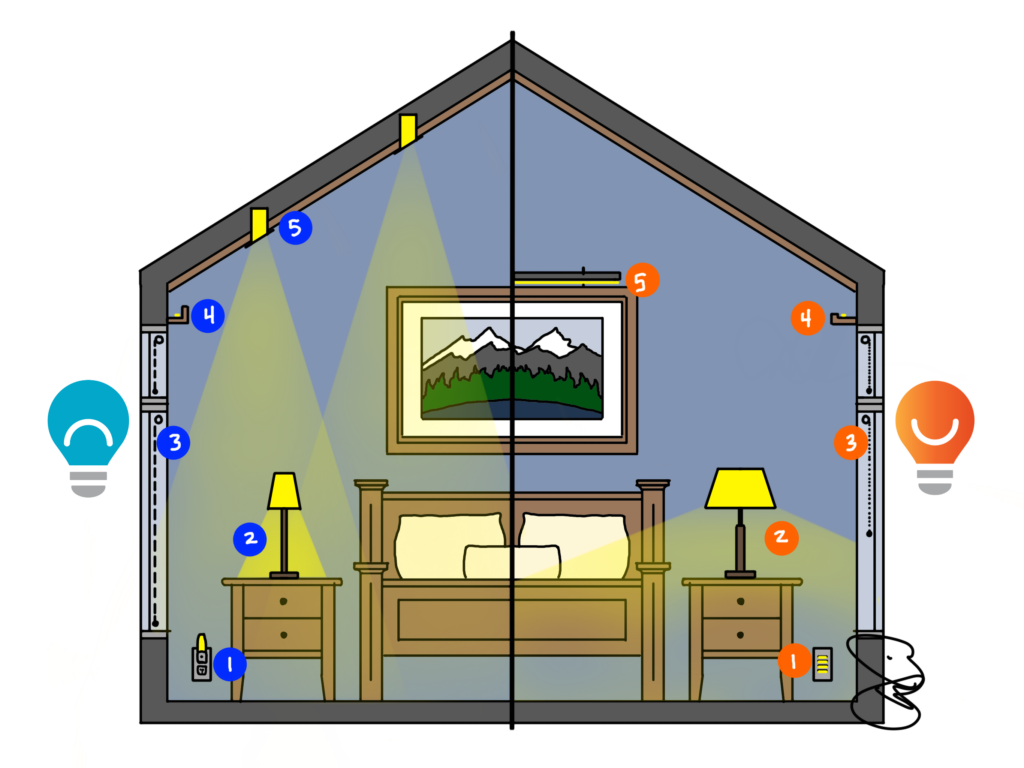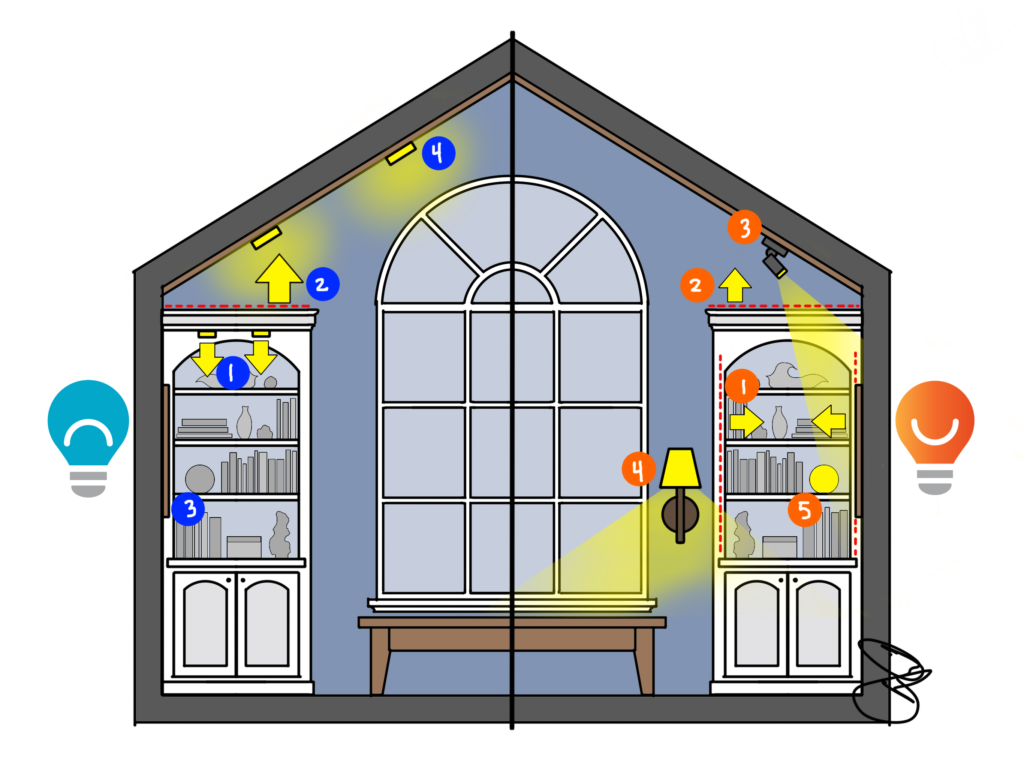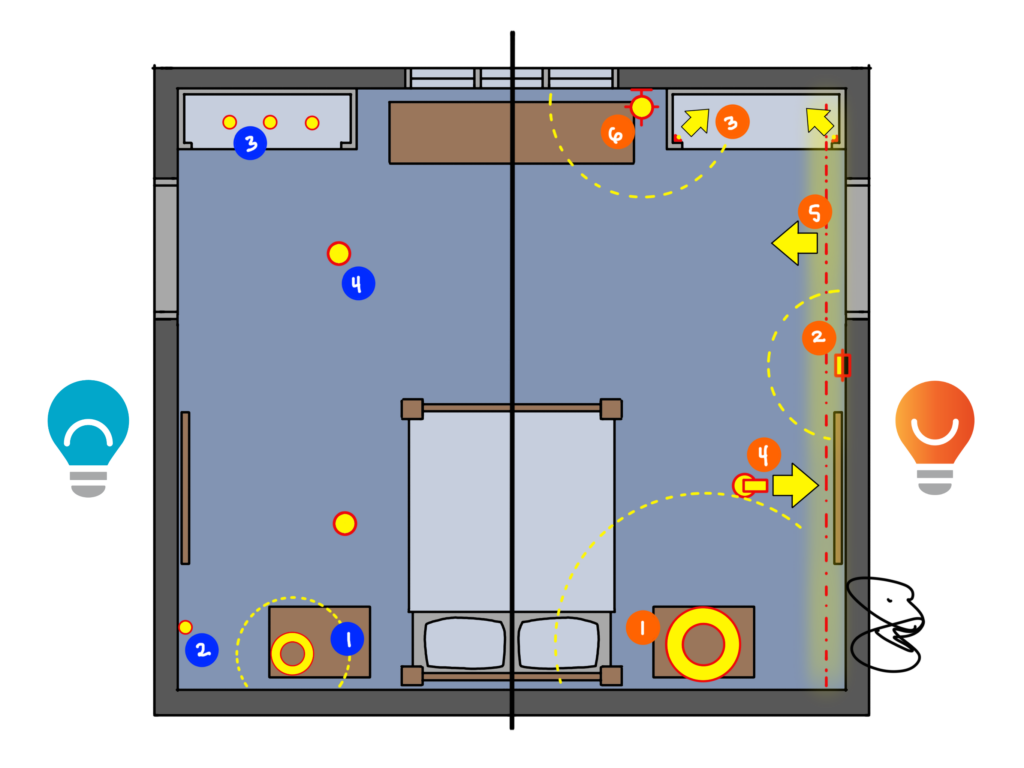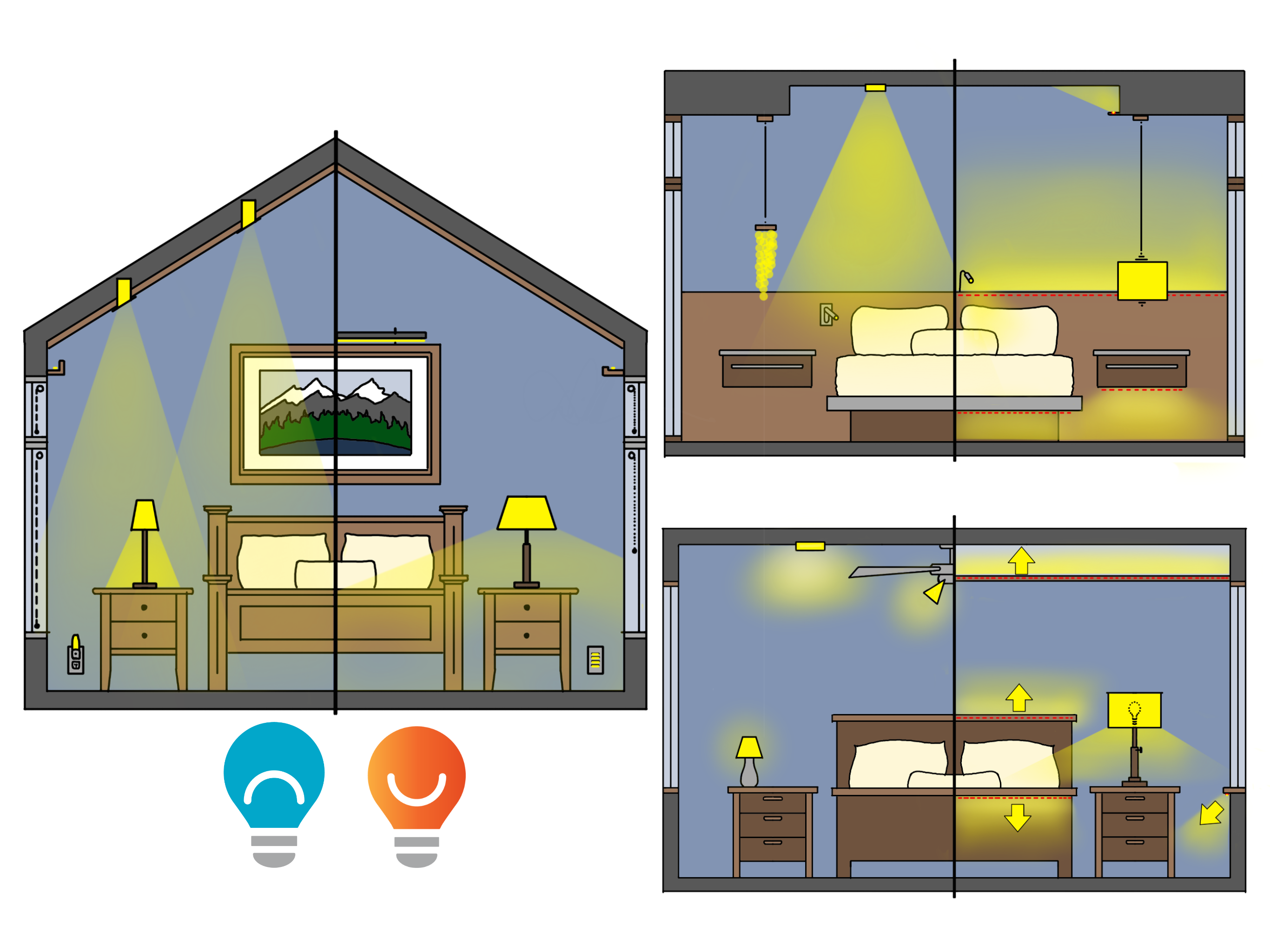One of my writing goals is to simplify the scientific and technical aspects of light into actionable advice, and the Don’t/Do This series is perhaps the most aligned with this purpose. The intent is to provide a simple list of strategies to utilize in a home, space by space, alongside pitfalls to avoid. Sounds easy, right?
Working against my simplification goals is a desire to provide the right answer, perhaps even to achieve mystical perfection and cover all the scenarios. That’s how I start out generating a “simple” list of do’s and don’ts for primary bedrooms…and wind up generating nine unique sketches and dozens of bullet points.
I think the ultimate outcome of this series could be a shortened set of House Rules for Lighting (HRL, because acronyms are critical to good lighting, just ask any IES or IALD member about LED, CRI, or CBCP). Perhaps later this year I’ll be able to skim through the executive summaries and pull those together into clear, concise, actionable advice.
Until then, you’ll have to wade through the house with me as I go room to room, thinking about spaces and imagining the mistakes and solutions along the way.
Here’s an summary of what I discovered while working on this post:
- Keep it dark. The first rule of sleeping is that we do it better in darkness- real darkness. Blackout shades or curtains that keep out light trespass from neighbors, streets, and sky glow are critical for good sleep. Light at night, as I explored in an earlier post, is just plain bad for us.
- Light the walls. This applies to every room in the house, not just the bedroom. Our “comfort zone” is what we see in front of us, and that should be softly illuminated. Art, furnishings, curtains, walls: all should be illuminated if we want to feel good. A side effect is that the room looks better, too.
- Glow the ceiling. Indirect light, when used on its own, can leave us in spaces that feel cloudy and gray. When used as a soft component of a layered strategy, however, indirect light bounced off the ceiling can make our spaces feel larger and more comfortable. This light is great for packing suitcases, making the bed, and waking up in the morning.
- Watch your step. Built-in steplights or underlit beds and side tables put light where we need it to see where we are going- and keep light out of our eyes for less disturbed sleep. These can be incredibly helpful when preparing for rest, and can come on with a soft, dim glow with a motion detector when we get out of bed in the middle of the night. Traditional night lights will likely disturb sleep and produce as much glare as helpful light, so read this and choose wisely.
- Respect your partner. If you sleep with someone else and are looking for reading light, make sure you consider their rest. Booklights that keep spill at a minimum are probably best, but built-in reading lamps can be far more convenient. It will be easiest to put these on each side of the bed, but that will require pointing the light towards your partner. Locate them in the middle of the bed and you can aim the light away from your partner. They’ll get more sleep and be nicer to you in the morning.
- Ditch the downlights. Recessed downlights in tidy patterns are the same technique used in gas station canopies. For a more restful space, forget downlights and disc lights, which can cause glare and unwanted shadows. Instead, use recessed adjustable lights or monopoint spotlights near the perimeter of the room to bounce light off the walls.
- Point it away. This may be the one rule to, er, rule them all: point lights away from your eyes. From puck lights inside shelves and cabinets that shine at your face to downlights do the same, we will be most comfortable when lights shine away from us and bounce of something else like artwork, walls, books, or ceilings.
And now let’s get into the details. This series is gradually expanding to include different styles of homes; when I first wrote do/don’t articles for Houzz.com, I just sketched a single version of each space. Now I find myself wanting to explore traditional, modern, simple, and more. In this post I’ll tackle traditional bedrooms with vaulted ceilings; in future posts I’ll cover modern and simple primary bedrooms.
THE TRADITIONAL BEDROOM

Looking Towards Bed
Don’t
- Old-school night lights. Receptacles are rarely in the right place for night lights, and most nightlights send their light outwards towards you instead of down at the floor. Without motion sensors, these nightlights glow all night long, which essentially puts your body in a heightened state of alertness waiting for sunrise.
- Tiny bedside lamps. We often choose lamps based on their appearance, not on the quality of light they produce. Tiny bedside lamps are not inherently bad, but they are usually not very good for reading…or for anything other than looking pretty.
- Sheer shades and translucent curtains. We need darkness for our best sleep – real, deep darkness. Shades and curtains that let in light will rob you of the deeper sleep you need. You may not wake up, but your body will be resting differently.
- Trapped coves. Cove lights used to be big, bulky, awkward fixtures like fluorescent bulbs, and coves were built large to hide them. An incorrectly sized cove today will trap light instead of spread it out softly over the ceiling. If you see a sharp divide of dark and light on your ceiling, your cove is not sized well.
- Downlights. Recessed downlights that point straight down are of limited utility and do little to help us feel comfortable. Instead, they put glare in our peripheral vision, leading to discomfort even when we don’t notice. We use very few straight recessed downlights in our work; a few in the showers perhaps.
Do
- Shielded night lights. Night lights that have shields and shades and project all the light downwards towards the floor will give you more useful light and stay out of your eyes for less sleep disruption. A motion sensor that only turns them on when you get out of bed would be perfect.
- Functional bedside lamps. Bigger, taller lamps that allow light to spill across your pillow area will provide more light for reading and better light in the room. Think of them as sunsets you can turn on and off on a whim.
- Blackout shades. Protect your sleep from invasive light from neighbors, passing cars, and sky glow from low cloud cover. You may not notice a difference, but your body and brain will. Some research even points to light at night as causal for dementia and other brain issues, so play it safe and keep it dark.
- Functional coves. A well-detailed cove can be quite small and relatively easy to construct, but it takes some thought to get it right. A functional cove will push soft light across the ceiling with no shadowing or awkward lines in corners.
- Picture lights. Vaulted bedrooms create challenges for lighting artwork, and picture lights can be an attractive and functional solution.

Looking Away From Bed
Don’t
- Puck lights in shelves. Puck lights are a little bit like whale oil lamps: the best we could do but no longer relevant. In most cases, puck lights, small round lights that tuck inside and underneath cabinets, provide uneven light at best and glare at worst.
- Bright uplights. Placing lighting on top of cabinets can be a great addition to any room- but not if they are too bright. Good lighting often just means dimming down some of what you already have. Think of it this way: the brightest light in a room should be on your hands for tasks or the walls for comfort. If it is anywhere else, like the ceiling, it’s in the wrong place.
- Dark walls. The only place in nature that has dark walls is a cave. Unless you are a bat or Batman, don’t leave the walls dark.
- Disc lights. These thin wafer lights, often called “canless recessed lights,” which is an oxymoron like “canless canned tuna,” are glare bombs in large rooms. Keep them in closets, utility rooms, and garages.
Do
- Sidelight shelves. There are a staggering number of ways to illuminate shelves. If your shelves are adjustable, try running linear LED tape light vertically on each side, facing in towards the middle. Light will fill the shelves and provide soft illumination in the room.
- Soft uplight. Light on top of cabinets, armoires, window frames, or any above-the-eye structure can be very comforting, so long as its not too bright.
- Monopoints. Vaulted ceilings make it extraordinarily difficult to get good light on walls and artwork. Monopoints, typically little spotlights on a canopy, provide much more adjustability than a recessed downlight. While most downlights can only adjust 25-35°, making it tricky even to get the straight down let alone “back” at the wall, monopoints can often do a full 90° of tilt.
- Wall sconces. I put a sconce above each windowseat in my bedroom in the first house I ever owned. They were great for reading, but also put a comforting burst of light into the room itself. Decorative fixtures at eye level, especially when dimmed to just the right level, are a must-have for me.
- Glowing objects. Wall sconces are not the only way to get sparkle in a room; shelves provide the perfect place for lanterns, glowing objects, small Tiffany lamps, or other purely decorative fixtures. Extravagant? Maybe, but also a very inexpensive way to make a room more comfortable. And with glowing accent lamps on, turning off all the other lights can make a bedroom more romantic without leaving you literally in the dark.

Plan View
Don’t
- Tiny bedside lamps. For reasons explained earlier, I shy away from purely decorative bedside lamps. They just don’t do enough for lighting the room or a book to be more than accents.
- Old-school nightlights. See above for a more detailed description. Suffice it to say, typical nightlights are in the wrong place, put light in your eyes, and will rob you of the deepest sleep cycles. There are better ways.
- Puck Lights. Like old-school nightlights, these need to go away and be replaced with better solutions. There are very, very few places where a puck light is the best choice.
- Disc Lights. They don’t belong in a primary bedroom, period. The room will feel bright if you use them, but only because your eyes are subjected to extraordinary glare. These are real mood-killers and sleep-disturbers…and look ugly.
Do
- Functional bedside lamps. Reading comfortably in bed requires a full-sized lamp, preferably one with soft linen-like shades that spread diffuse light through the room.
- Shielded nightlights. Point it away from your face. Away from your face. Away.
- Sidelight shelves. We have better tools today, like linear LED tape light, to illuminate shelves. Sidelighting is just one option, but a pleasing look and relatively easy to install.
- Monopoints. Use these little spotlights in sloped ceilings for their unique adjustability so you can properly illuminate walls, tall cabinetry, and artwork.
- Functional coves. Size the cove to allow light to softly spill across the ceiling instead of being trapped and causing bright lines of light at the ceiling edges.
- Wall Sconces. Comfort while seated is most easily achieved by having one lamp over your shoulder for glare-free illumination and one lamp, like a wall sconce, across the room from you for comfort. And when you are on the windowseat, the sconce will be over your shoulder and the bedside lamp across the room.
That wraps up the traditional bedroom. In a future post I’ll carry these ideas into modern and simple bedrooms.
As you consider lighting your own spaces, keep in mind that what I share here is a list of possible solutions – it may not be practical or even advisable to implement all of them at once. I’ll keep exploring different ways to simplify this stuff…to find ways for us all to understand how different layers of light can help us live our best lives. And if you have any suggestions, I’m all ears!
Read more of my DON’T/DO THIS series HERE.
Read my 1THING: Primary Bedrooms post HERE.
